- New Tanker Additions Expected in Russian Crude Trade.
- TC2 Earnings Surpass TC14, Restoring Market Balance.
- Tight MR Supply in Europe Drives Market Shifts.
The growth of the TMX pipeline is heavily boosting Aframax voyages out of Canada, with an increasing number of crude shipments now shipping to Asian terminals. With Canadian crude exportation to the US decreasing, Asia is becoming the new major destination. Ever since June 2024, ship-to-ship (STS) voyages unloading at the Pacific Lightering Zone have decreased consistently, marking a change in trading flows, reports Break Wave Advisors.
Increasing Freight Rates on Vancouver-China Route
This has also affected freight rates, with dirty tanker rates on the China-to-Vancouver route at their highest since September 2024. Rates have risen from $30 per tonne to $37.5 per tonne in February 2025, as per Argus. The changing US tariff environment is set to further entrench this trend, making Asia an even more robust trade partner for Canadian crude.
Increasing Aframax Fleet in the Canada-Asia Trade Cycle
A specific fleet of Aframax ships is now in a cycle, lifting crude from Canada, discharging in Asia, and coming back for the next trip. Nine ships are currently ballasting from the Pacific to Canada’s West Coast, and additional ships are likely to join this trade stream as volumes rise. The constriction of tonnage supply in the Asia-Pacific basin could continue to push Aframax freight prices upward in the next few months.
Indications of Oil Flow Regaining Through Bab-El-Mandeb
Oil flows via the Bab-El-Mandeb (BEM) Strait are experiencing a slow recovery, especially in the clean petroleum products (CPP) segment. CPP Middle East Gulf (MEG) to Wider Europe voyages have picked up slightly since late December. Yet volumes are much lower than they were in 2023, with first-half February CPP flows totalling only 110,000 barrels per day—just 16% of last year’s average.
Influence of Risk Premiums and Red Sea Uncertainty
Despite this slight rise, risk insurance premiums for high-risk areas and shipowners’ ongoing hesitancy to sail through the Red Sea are maintaining BEM transits at record lows. The decline in CPP flows from the MEG to Europe has also taken its toll on Cape of Good Hope (COGH) voyages, with poor arbitrage economics further cutting middle distillate exports to the region. The proportion of MEG exports to Wider Europe has decreased from 15% in September 2024 to only 9% in February 2025.
Pressure on Clean Tanker Freight Rates
The reduction in CPP exports by the MEG to Europe has also lowered tonne-mile demand on this route. If arbitrage economics continue to be weak or oil flows through BEM are fully reinstated, clean tanker freight rates, especially for TC8 and TC20 routes, may come under further pressure.
OFAC Sanctions Redefine Russian Crude Tanker Traffic
The imposition of OFAC sanctions on January 10 has had a major impact on Russian crude exports, with 155 crude oil tankers effectively taken out of commission from participating in further Russian trade. The effect is seen in the precipitous drop in distance travelled by these ships, as many sit idle offshore. Russian crude cargoes are piling up on stranded ships, with seven loaded tankers now stranded offshore in Russia’s Far East, probably waiting for ship-to-ship operations to unload their cargo.
Challenges in Finding Employment for Sanctioned Ships
The reduction in ballast voyage lengths indicates that these ships are finding it difficult to find employment, as market players are still wary of violating US sanctions. While these sanctions are at the moment limiting Russian crude exports, the trade may once again be attractive if additional discounts on Russian barrels spur renewed demand from China and India.
New Russian-Trading Fleet Additions
But changes in market dynamics are still seen to come given the expected addition of new players into the Russian-trading fleet. There were reports that around 20 years old or above Western-operated Aframaxes have been sold, which would mean fresh entries into Russian crude trade sooner than later.
TC2 Earnings Rebound, Outperforming TC14
For the first time since summer 2024, TC2 earnings have been beating TC14 consistently, marking a return to a more conventional front-haul market pattern in the Atlantic Basin. The change is being fueled by a string of market factors that remain supportive of medium-range (MR) tankers from Europe but bear down on freight levels in the US Gulf.
Tight MR Supply in Europe and Shifting Trade Patterns
The low availability of MRs in Europe, thanks to Russian diesel exports out of the Baltics, has created a squeeze in supply. Concomitantly, numbers of MR ballasters into Europe post-discharging at PADD 1 have continued to be limited, curtailing competition locally. Instead, many MRs have moved on to the US Gulf, keeping that market freight down.
Likely Market Drivers of TC2 Growth
Additional developments may still support TC2 in the near term. If the US imposes tariffs on Canadian crude, the nation may look more and more to Europe to displace gasoline supplies, driving further TC2 demand. On top of that, future US Gulf refinery maintenance should lower support for MR diesel transatlantic voyages, keeping TC14 earnings weak.
Did you subscribe to our daily Newsletter?
It’s Free Click here to Subscribe!
Source: Break Wave Advisor

























